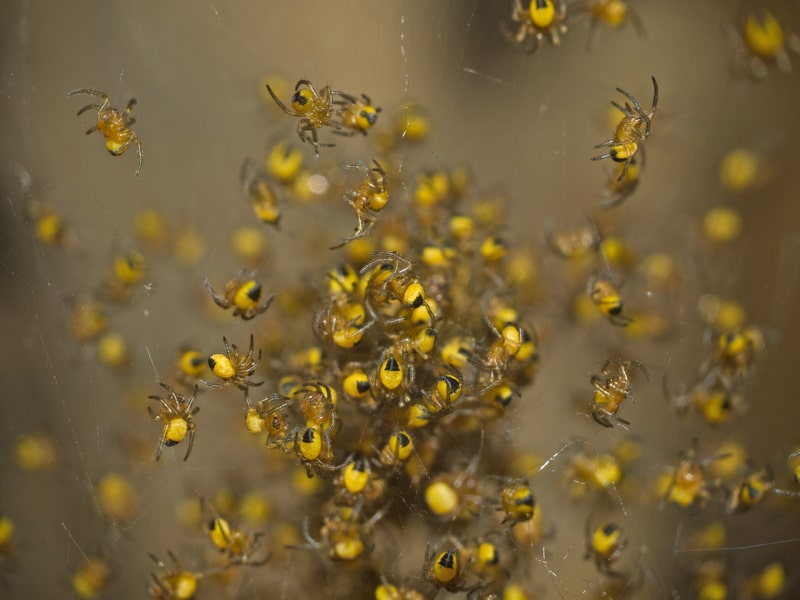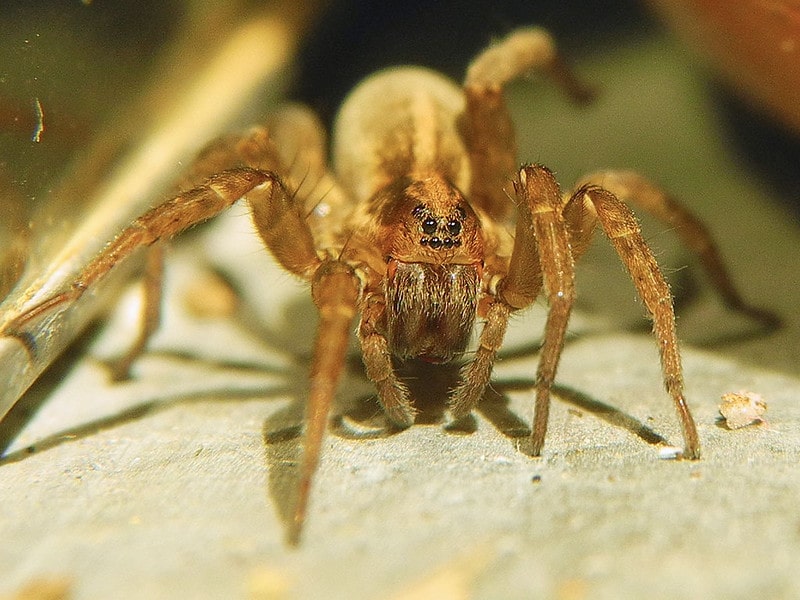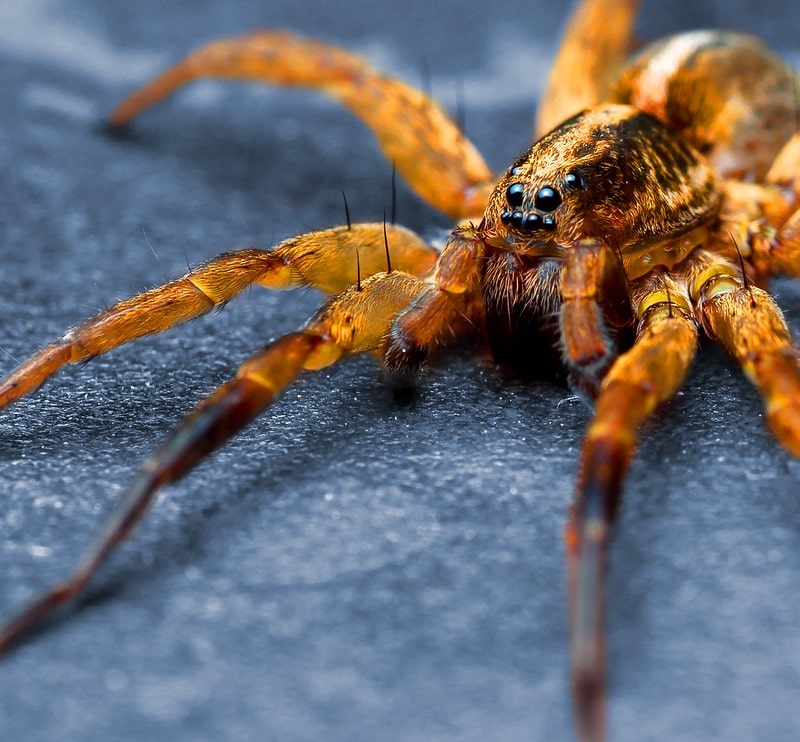Last updated on December 26th, 2022
Spiders are everywhere from the Amazon jungles to home gardens. Don’t be scared if you see one. They rarely bite people, and most venoms aren’t life-threatening. Instead, allow yourself to be fascinated by these natural weavers. No other animal can build homes, spring traps, and make shields quite like they do. They have inspired songs, stories, and symbolisms. They are also making their mark on medicine, fashion, and defense, thanks to pioneers who are keen on unlocking the secrets of spider silk. Spiders have much to teach us. With these 60 interesting facts about spiders, let us learn more about these air-breathing arthropods.
Origins and General Facts about Spiders
1. Etymology
After seeing them make webs, ancient Germanic tribes called these creatures “spin-þron” which literally means “spinner”. The word evolved over the millennia into its current form: spider.
2. Creation Before Control
Spiders didn’t become expert weavers overnight. Their ancestors first developed the ability to make silk around 386 million years ago, but they couldn’t control it.
3. Necessity is the Mother of Invention
The first modern spiders emerged 240 million years ago, a time when flying insects were becoming abundant. Spiders needed a way to catch these, so they learned to spin silk and create sticky aerial traps.
4. Biggest Fossil Spider
In 2005, Inner Mongolia farmers found an inch-long fossil spider — gigantic compared to past specimens. It died 165 million years ago and was preserved by volcanic ash.
5. Impressive Diversity
Spiders around the world have adapted to their environment and branched out into 50,000 distinct species – the 7th most diverse order among all organisms. The 50,000th spider registered is the Guriurius minuano.
6. Biomass
The total mass of spiders on earth is estimated at 25 million tons. As excellent hunters, they can consume a total of 400 to 800 million tons of prey each year.
7. Spiders Are Not Insects
Spiders are arachnids, not insects. Look closer to see the difference. They don’t have antennae, wings, or a midsection. They have eight legs instead of six.
8. Longevity
Life is short for most spiders. They typically last a year, although tarantulas are known to live up to 25 years in captivity.

9. Spider Societies
Most spiders are solitary, but some are social animals that can form colonies of up to 50,000 members. Multiple generations share the same nest and care for the brood.
10. Related Species
Spiders are arthropods, which means they are invertebrates with exoskeletons. Their closest relatives are scorpions, mites, and ticks – all under the class arachnida.
Spider Anatomy Facts
11. Straw Mouth
Did you know that spiders can’t chew? They digest prey outside their body by spraying acidic enzymes. Their mouth has a short straw to consume the liquified food.
12. Fangs
Spider fangs often stay hidden, swinging out only to inject prey with paralyzing venom. This chemical weapon reduces the risk of a dangerous struggle.
13. Hairy Legs
When spider senses are tingling, that’s probably just their hairy legs. The strands are sensitive enough to pick up scents and sounds in the environment.
14. Book Lungs
Spiders have a pair of book lungs in their abdomen. It consists of alternating air pockets and blood-filled tissue, which looks a lot like a stack of pages under a microscope.
15. Spinnerets
At the end of the abdomen are one to four pairs of spinnerets. Silk comes out of these small appendages, which carefully weave them into intricate patterns.

16. Eyes
Most spiders have eight eyes, each with a single lens. Hunting spiders tend to have excellent color vision, but web-bound spiders often have poor eyesight.
17. Vibration
Spiders with poor vision make up for it with their extreme sensitivity to vibrations. They can sense waves on soil, water, or their own silk threads.
18. Air Pressure
Spiders can also detect changes in air pressure around them, giving them an additional method of finding the location of their prey.
19. Size Range
The smallest spiders are barely visible at under 0.37 mm long. The largest are likely to strike fear with a leg span that’s almost 10 inches.
20. Color
Most spiders have shades of black, brown, green, white, or silver. Some can change color based on what they eat. A few can instantly match their surroundings to hide.

Spider Behaviour Facts
21. Mating Ritual
Spider dating is a dangerous game. Wary females may eat males who wander into their territory. Males perform courtship rituals to make their intention clear and stay safe.
22. Sacrificial Males
Some male spiders literally die for love. After mating, they don’t escape to safety. Instead, they sacrifice themselves, jumping directly to the female’s venomous fangs.
23. Sacrificial Mothers
In certain species, spider mothers may die while guarding their eggs. When these hatch, the baby spiders feed on the corpse to grow stronger.
24. Spiders Have a Sweet Tooth
Juvenile spiders love sweet nectar: rich in lipids, amino acids, vitamins, and minerals. It’s less stressful. No need for venom or digestive enzymes. No grappling with prey.
25. Spider Scavengers
Hustle culture is overrated. Instead of hunting, spiders may search for dead arthropods or eat protein-rich webs, including pollen caught in the threads.

26. Web Orientation Strategies
Spiders can weave their webs vertically to catch insect mid-flight. They can also build horizontally to trap insects that are flying up after feeding from flowers or other vegetation.
27. Casting Nets
Some spiders weave small nets and cast these onto their prey to like a trap. Passive species simply stretch, wait for contact, and release. More aggressive species lunge and push the net onto their prey.
28. Ambush Predators
Not all spiders make web traps. Some hide in burrows and wait for insects to crawl nearby. In a snap, they’ll open a door and grab the unsuspecting prey into their hole.
29. Chasing Prey
Jumping spiders are intrepid explorers. They move around and chase their prey, allowing them to cover a wider area. These are highly intelligent hunters who can use trickery
30. Mimicry
Spiders may mimic ants by making their front legs look like antennae, leaving them with six walking legs. They can also behave like part of the colony. The disguise protects them from predators like lizards, and helps them prey on ants and aphids.
| Some common questions about spiders | |
|---|---|
| 1. | |
| 2. | |
| 3. | |
| 4. | |
| 5. | |
| 6. | |
| 7. | |
| 8. | |
| 9. | |
| 10. | |
| 11. | |
| 12. | |
| 13. | |
| 14. | |
| 15. | |
| 16. |

Spider Web Facts
31. Composition
Spider silk is a long protein fiber. It is slightly acidic to repel fungi and bacteria. Different silk glands produce different types of fibers: sticky silk for catching prey, fine silk to wrap the catch, and so on.
32. Silk Production
Inside spiders are glands with liquid silk. Fibers are made on demand. They can use their legs to pull threads away from their body, or rely on their weight to create a trail as they hang down.
33. Evolving Use of Silk
The ancestors of spiders used to live on water. When they moved to land, they made silk to protect their eggs and their bodies. Over time, it became a tool for sending signals, creating guide lines, ground webs, and finally aerial webs.
34. Energy Savings
One of the benefits of building webs is that spiders don’t have to stray far and run around. They save energy by remaining in one area, letting food come to them.
35. Web Recycling
Spiders are natural conservationists. Instead of abandoning old ineffective webs, many will eat these to recover the protein and get fresh raw materials to build a new one.
36. Wind Sailing
Certain spiders squirt long silk threads into the air and let the wind blow it several meters away. These become a highway for crossing safely to another location — useful if the ground is filled with predators.
37. Low-gravity Construction
In 1973, astronauts took spiders into space to observe the effects of zero gravity. It took a day for these to adapt to weightlessness and complete a web. After this was destroyed, they made a second web which was more elaborate than the first.

38. Spot the Difference
Scientists found that space-spun webs had finer threads and a slightly different pattern than those on Earth. A light source reduced disorientation, allowing spiders to build normally despite zero gravity.
39. Web Strength
Spider silk has a tensile strength that exceeds steel of the same weight. It is also more elastic, making it a good candidate for artificial tendons.
40. Conductive Material
Spider webs can conduct electricity. Since flying insects develop a static charge, they attract the silk as they approach. The threads spring out to meet them, making it harder to evade.
Spider Applications
41. Cobweb Paintings
In the 16th century, artists in the Austrian Alps stretched cobwebs over cardboard and strengthened the strands with diluted milk. They brushed this with watercolor to create beautiful images.
42. Traditional Medicine
Before the arrival of modern medicine, European doctors applied cobwebs on wounds to reduce bleeding and promote healing. It worked thanks to the blood clotting property of the web’s Vitamin K.
43. Musical Instruments
Nigerians make musical instruments using animal parts such as cow horns for their xylophones. These have holes covered in spider webs to induce a buzzing sound.
44. Military Protection
Some telescopic rifle sights use fine spider web for their crosshairs to improve accuracy. The military is also trying to develop spider silk body armor to protect troops on the battlefield.
45. Venom Medicine
Spider venom is now being used as a natural insecticide. It’s an intriguing alternative for fruit and vegetable farmers that want to move away from harmful chemicals.

46. Insulin Pump Alternative
In 2015, scientists reported the creation of engineered tissue using spider silk, bacteria, and insulin-producing cells. They hope to turn this into a replacement for mechanical insulin pumps.
47. Spider Silk Fashion
Fashion designer Stella McCartney and synthetic spider silk company Bolt Threads are creating sustainable fabrics. The material is made from spider silk genes, sugar, and yeast.
48. Running Shoes
Want to speed up? Train hard and wear lightweight shoes. Adidas created prototypes featuring lightweight high-strength threads with synthetic spider silk.
49. Light Parka
The North Face has created lightweight parka using spider super-silk. Japanese startup Spiber launched its own Moon Parka to celebrate the Apollo 11 landing.
50. Breast Implant Coat
Breast implants are prone to bacterial infection. Scientists are applying a coat of spider silk around the implants to shrug off bacteria and prevent immune system issues.

Spiders in Culture
51. The Talented Mortal Arachne
In Greek mythology, Arachne was a skilled weaver who challenged Athena and won. Infuriated, the goddess turned her into a spider who is condemned to weave forever.
52. Aunt Nancy
Anansi is a tricky spider in West African myth. Slaves carried the story to the US, where the name changed into Aunt Nancy. It inspired Neil Gaiman’s novel “Anansi Boys.”
53. Nazca Spider Geoglyph
Over 2000 years ago, Nazca people of Peru made giant mystical drawings by digging rust-colored ground. One of them is a spider, visible only through aerial surveys.
. . . continue reading on the next page
